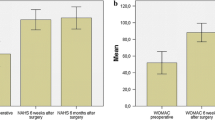Abstract
Purpose
The goal of this study was to determine how frequently the conventionally defined “idiopathic” chondrolabral hip injuries are associated with subradiological cam deformities of the head–neck junction and whether a protective femoral osteochondroplasty may improve the outcome of their arthroscopic treatment.
Methods
All the non-arthritic or pre-arthritic painful hips diagnosed as having a primary chondrolabral injury were retrospectively evaluated. Coxometric data, clinical history and physical findings were reviewed to rule out any possible secondary lesion. The medical records of the selected cases were analyzed as for imaging features, surgical findings and post-arthroscopy outcome.
Results
Three cases out of 79 chondrolabral injuries were identified as “primary” on the basis of the preoperative assessment. All the three patients were female in their fourth decade and showed a joint damage consistent with undetected cam FAI (cartilage delamination in the anterolateral acetabular quadrant, minor pathology of the adjacent labrum with or without chondrolabral separation, abrasion signs and herniation pits along the anterolateral head–neck junction). The first patient received a simple chondrolabral treatment whose benefits deteriorated few months after surgery; the second patient underwent chondrolabral repair and femoral osteochondroplasty and is still pain-free; and the third patient had a beneficial revision arthroscopy for femoral osteochondroplasty after prior unsuccessful chondrolabral surgery.
Conclusions
If a chondrolabral injury of the hip is associated with MR arthrographic and arthroscopic indirect signs of cam FAI, a subradiological head–neck deformity should be considered despite normal alpha angles. In such cases, a protective femoral osteochondroplasty may increase the success rate of the chondrolabral repair.
Level of evidence
IV.










Similar content being viewed by others
References
Lage LA, Patel JV, Villar RN (1996) The acetabular labral tear: an arthroscopic classification. Arthroscopy 12:269–272
Wenger DE, Kendell KR, Miner MR, Trousdale RT (2004) Acetabular labral tears rarely occur in the absence of bony abnormalities. Clin Orthop 426:145–150
Guevara CJ, Pietrobon R, Carothers JT, Olson SA, Vail TP (2006) Comprehensive morphologic evaluation of the hip in patients with symptomatic labral tear. Clin Orthop 453:277–285
Field RE, Rajakulendran K (2011) The labro-acetabular complex. J Bone Jt Surg Am 93(Suppl 2):22–27
McCarthy JC, Noble PC, Schuck MR et al (2001) The Otto E Aufranc Award the role of labral lesions to development of early degenerative hip disease. Clin Orthop 393:25–37
McCarthy JC, Noble PC, Schuck MR, Wright J, Lee J (2001) The watershed labral lesion: its relationship to early arthritis of the hip. J Arthroplasty 16(8 Suppl. 1):81–87
Beck M, Kalhor M, Leunig M, Ganz R (2005) Hip morphology influences the pattern of damage to the acetabular cartilage: femoroacetabular impingement as a cause of early osteoarthritis of the hip. J Bone Jt Surg Br 87(7):1012–1018
Matsuda DK (2011) The case for cam surveillance: the arthroscopic detection of cam femoroacetabular impingement missed on preoperative imaging and its significance. Arthroscopy 27(6):870–876
Tönnis D, Heinecke A (1999) Acetabular and femoral anteversion: relationship with osteoarthritis of the hip. J Bone Jt Surg Am 81(12):1747–1770
Tannast M, Siebenrock KA, Anderson SE (2007) Femoroacetabular impingement: radiographic diagnosis–what the radiologist should know. AJR Am J Roentgenol 188(6):1540–1552
Notzli HP, Wyss TF, Stoecklin CH, Schmid MR, Treiber K, Hodler J (2002) The contour of the femoral head–neck junction as a predictor for the risk of anterior impingement. J Bone Jt Surg Br 84:556–560
Kelly BT, Philippon MJ (2007) Arthroscopic hip anatomy. In: Callaghan JJ, Rosenberg AG, Rubash HE (eds) The adult hip. Lippincott, Williams & Wilkins, Philadelphia, pp 68–80
Dudda M, Albers C, Mamisch TC, Werlen S, Beck M (2009) Do normal radiographs exclude asphericity of the femoral head-neck junction? Clin Orthop 467(3):651–659
Kolo FC, Charbonnier C, Pfirrmann CW, Duc SR, Lubbeke A, Duthon VB, Magnenat-Thalmann N, Hoffmeyer P, Menetrey J, Becker CD (2013) Extreme hip motion in professional ballet dancers: dynamic and morphological evaluation based on magnetic resonance imaging. Skeletal Radiol 42(5):689–698
Kapron AL, Anderson AE, Peters CL, Phillips LG, Stoddard GJ, Petron DJ, Toth R, Aoki SK (2012) Hip internal rotation is correlated to radiographic findings of cam femoroacetabular impingement in collegiate football players. Arthroscopy 28(11):1661–1670
Conflict of interest
None.
Ethical standards
All procedures performed in studies involving human participants were in accordance with the ethical standards of the institutional and/or national research committee and with the 1964 Helsinki declaration and its later amendments or comparable ethical standards. Since the study is retrospective, no formal approval is requested. Informed consent was obtained from the patients whose history and imaging (although anonymized) is reported within the article.
Author information
Authors and Affiliations
Corresponding author
Rights and permissions
About this article
Cite this article
Pierannunzii, L., Guarino, A. Subradiological cam deformity of the head–neck junction: an occult cause of hip pain and chondrolabral damage. Musculoskelet Surg 99, 113–119 (2015). https://doi.org/10.1007/s12306-015-0368-x
Received:
Accepted:
Published:
Issue Date:
DOI: https://doi.org/10.1007/s12306-015-0368-x




